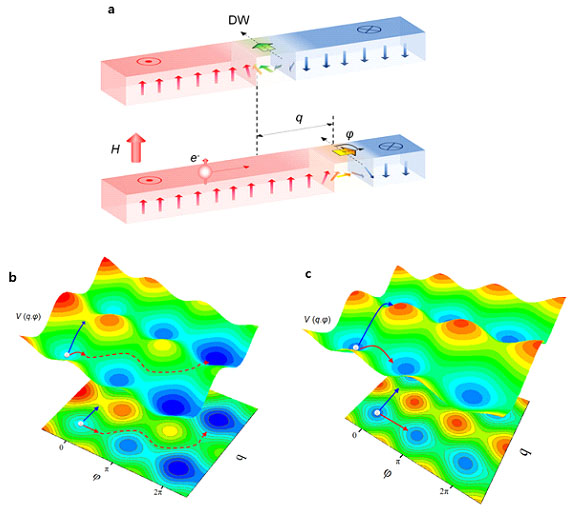Prof. Ono, T., et. al. “Two-barrier Stability that Allows Low Power Operation in Current-induced Domain Wall Motion” (Published in “Nature Communications” 17 June 2013)
|
Two-barrier Stability that Allows Low Power Operation
Published in “Nature Communications“(Online Publication, June 17, 2013).
Prof. Ono, T., et. al. (Nanospintronics, Division of Materials Chemistry) |

Mr. Hiramatsu, R.(Back Left) Mr. Ueda,K.(Back Middle) Prof. Ono, T.(Back Right) Assist Prof. Kim, K.-J.(Front Left) Ms. Yoshimura Y.(Front Right). |
|||
|
Kab-Jin, Kim1, Ryo Hiramatsu1, Tomohiro Koyama1,2, Kohei Ueda1, Yoko Yoshimura1, Daichi Chiba1,2,3, Kensuke Kobayashi1,4, Yoshinobu Nakatani5, Shunsuke Fukami6, Michihiko Yamanouchi6,7, Hideo Ohno6,7,8, Hiroshi Kohno4, Gen Tatara9,10, Teruo Ono1 1 Institute for Chemical Research, Kyoto University |
||||
|
Energy barriers appear in diverse systems and its determination has long been a debatable issue because it determines the thermal stability of devices as well as the threshold force triggering their dynamics. In general, there is a severe dilemma between the thermal stability of bit data and the operation power of devices, because larger energy barrier for higher thermal stability inevitably leads to larger magnetic field (or current) for operation. Here we show that this is not the case for the current-induced magnetic domain wall motion induced by the adiabatic spin transfer torque. By quantifying domain wall depinning energy barriers by magnetic field and current, we have found that there exist two different pinning barriers, extrinsic and intrinsic energy barriers, which govern the thermal stability and threshold current, respectively. This unique two-barrier system allows the low power operation with high thermal stability, which is impossible in conventional single-barrier systems. |
||||
 |
||||
| Schematic illustration of DW motion and energy landscape. a, A magnetic DW in a nanowire and its collective coordinates, the position q and the tilting angle φ.b,c, Energy landscape for the DW motion in the presence (b) and absence (c) of d.c. current. Here, the periodic potential along q direction is not the exact energy barrier but an illustrative one to represent typical energy barrier. In b, the d.c. current tilts the potential in the φ direction. Once the DW is excited above the intrinsic barrier (indicated by the red solid arrow), it evolves dynamically along the red dotted curve and eventually overcomes the extrinsic barrier which is lowered by the tilting. Note that the threshold is determined by the intrinsic barrier when the intrinsic barrier is lower than the extrinsic one. Thermal excitation overcoming the extrinsic pinning potential along q axis (blue arrow) is blocked due to high energy barrier. In c, there is no tilting in the energy landscape. When the intrinsic barrier is lower than the extrinsic one, the DW may easily overcome the intrinsic barrier (red arrow), but this does not lead to the depinning from the extrinsic barrier since it does not change q. The DW depinning from the extrinsic pinning occurs only when it overcomes the full extrinsic barrier (blue arrow). | ||||
| Kim, K.-J.; Hiramatsu, R.; Koyama, T.; Ueda, K.; Yoshimura, Y.; Chiba, D.; Kobayashi, K.; Nakatani, Y.; Fukami, S.; Yamanouchi, M.; Ohno, H.; Kohno H.; Tatara, G.; Ono, T., Two-barrier Stability that Allows Low-power Operation in Current-induced Domain-wall Motion, Nature Communications 4, Article number:2011, doi:10.1038/ncomms3011 (2013). | ||||
 Institute for Chemical Research, Kyoto University
Institute for Chemical Research, Kyoto University International Joint Usage Research Center
International Joint Usage Research Center